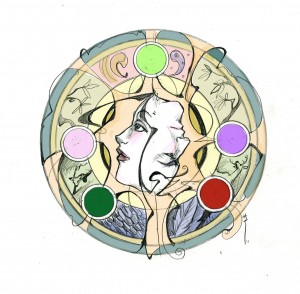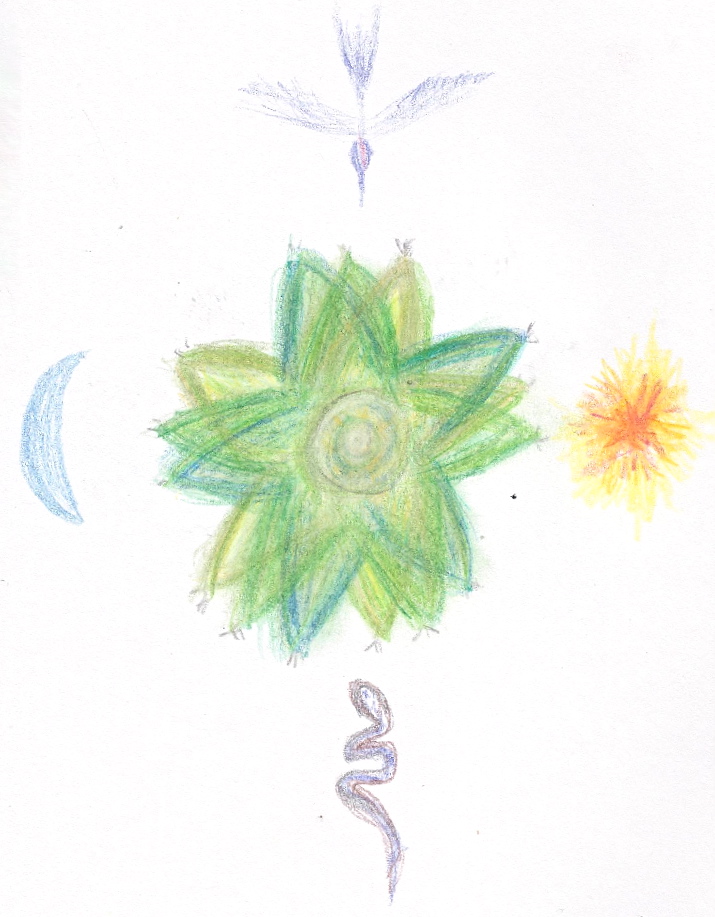A Mandala is a circle. The first syllable is accented, as it is a Sanskrit word and not from Latin roots.
The Mandala usually has a balance of elements, symbols. It is a symbolic representation of the whole, as a certain realm of experience.
A yantra is a mandala, as are rose windows, flower of life- we see them everywhere in sacred art forms. They can be very geometric or full of deities and natural symbols.
An animated view would see it this way:
“Everything that happens in our life is our deeper self calling to us and leading us home.” ~Reggie Ray
Whatever happens is appropriate for leading us to the next stage
Ecstatic experience of the divine or the totality reminds us of our existence beyond the limited self, but so do the more confining experiences along the continuum. Illness reminds of of the frailty of the body, the mind, the ego, in fact. An time we feel the shakiness of the ego-centered self, we are reminded in our training to look outward, not to external saviors, but to our world as a mandala of our whole life. We need to let our awareness saturate the life of which we are the center, so we can experience our karma, the resonance of our thoughts and actions in our personal world.
To experience our mandala, the way the universe of consciousness is expressing itself through our being, we must approach with an attitude of utter non-judgement; see the fear, obstacles as part of the landscape, part of ourselves, our life.
We can then approach other people with a clearer view once we learn to trust our own life and our own experience.
A Buddhist Mandala: In the center is a buddha, around it is all the experience of life. inner circle of sacred fire around Buddha.
We are willing to go through the fire into the center of the mandala, where the enlightened buddha, us, sits. The fire is all the experience that we need to go through make the spiritual journey. No one can do this for us but we have teachings and we have our body and our karma that give us the path.
“There is no other way. We need to let go of security, invulnerability, and familiar territory of our own ego and journey into a space that is new and fresh, ever unfolding, ever unknown.” ~ Reggie Ray
This is the motivation and the method.
Meditation:
Doing mandala work in the contemplative life involves certain meditation techniques and visualizations. The Whole Body Meditation techniques we use at PI are useful, as is mudra practice from Chogyam Trungpa. Any practice where you start by centering yourself, give rise to a compassionate heart that can hold all beings without resentment or desire, and radiate your awareness slowly outward in all directions, even down into the earth and up through the sky, experiencing all the elements. You include all people and all beings from your inner circle outward, exploring what particular hot or cold connections you have with them. See the as part of your Life, your life force, your world as it arises moment to moment. Some people from the past are there as part of the geography. It’s interesting. This experience lets you see the world from everyone’s perspective. Them when you go out as far as you can in all directions, you can let your awareness gather back into your self, feeling a little more balanced and spacious.
This is the Huachuma Mandala, a simple transmission of the energies of a plant that is very sacred in Peruvian Shamanism, centered within the directions and elements of the Mesa:
Here is an excerpt from a talk by Dr. Judith Simmer-Brown on the way the Mandala Principle is understood in the Tibetan Buddhist tradition. It is not the only way mandalas are understood, but it is very helpful.
“The Mandala Principle in Tibetan Buddhism is a principle of sacredness and diversity going together. That is, that in any complete world there are people and situations that are radically different in the way they are set up, but each of them have a very special quality of wisdom about them. So, in the Mandala Principle as it is taught in Tibetan Buddhism there are what are called five Buddha families—five styles of enlightened wisdom. Each of them carries a neurotic side—that is, a way in which this kind of wisdom can get fixated on ego and cause a great deal of pain for oneself and others. But the purpose of practice in Tibetan Buddhism is to liberate the wisdom within one’s most painful lifestyles and thought and emotional patterns so that one brings that particular quality out as a gift to the world.
I’d like to describe each of the families and we would like you to begin to try to figure out which one might most describe your predominant style. In the Mandala Principle and the way it has been taught in our community, there’s a sense that you have several other traits but there is one that is more dominant and more obvious, especially to your friends and family. [laughter] At Naropa University, we do a great deal of work with these five. In fact, the five competencies that we train our students in are in developing all of these traits. Also, we do practices in five colored rooms and work with the students in identifying their particular areas of blockage and how it is that by practicing and contemplating and cultivating mindfulness they can bring out the wisdom of each of these five families.
So, I’ll begin with what is known as the blue which is spoken of as the Vajra family or the thunderbolt family. This is the family that in its neurotic style tends to be picky and critical but in its wisdom style is oriented toward precision and order, and intellectual clarity. So, as one brings out these qualities, there’s a sense of greater clarity about the details of one’s world. But if one is clouded by ego then it can become pickiness and complaining.
The yellow is the Ratna family or the jewel family, known in its neurotic style for being overly bossy and domineering, but in its enlightened style as extremely resourceful. Yellows may take a situation where nothing is really happening and enrich it with a sense of excitement and interest and curiosity in everyone in its presence. So that’s the yellow.
The third one is the red, which is the Padma family or lotus family. This is the family that in its neurotic style is overly concerned with relationship and with what other people think, and has a tremendous need, almost a clinginess, in the area of emotional intimacy. But in its wisdom side red has a tremendous ability to create close relationships and to support the development and blossoming of another person. There is also a tremendous ability to make friends with anyone one encounters and to draw out the richness of that person. That’s red.
The fourth one, green, is the Karma family or the action family. This is efficiency and in its neurotic element has a tremendous sense of speediness and always needing to do something. But in its wisdom side, there is a tremendous ability to accomplish things, a “cool under fire,” energy and efficiency and practicality of being able to get things done.
The fifth one is white, known as the Buddha family or the awake family, which in its neurotic element can be very cloudy and spaced out and seems not to really ever have an opinion on any subject. But in its wisdom side, white has a tremendous ability to accommodate or adapt to any situation and has incredible powers of listening and touching the wakefulness in every life situation.
The basic Mandala Principle in Tibetan Buddhism is that we all have all five of these kinds of wisdom but we have one of them especially, and we tend to feel that it’s a problem and we want to get rid of these qualities. But if we can liberate the wisdom energy in each of these, there are tremendous gifts we can offer any particular group situation or larger situation. So, the purpose of meditation practice is to liberate the ego-clinging out of these neurotic tendencies so they become wisdom gifts to the world.”
taken from http://www.monasticdialog.com/a.php?id=450
The Tibetan Mandala system reminds us that everything is just an energy, not inherently good or bad. All of our qualities and situations are inherently neutral. If we practice meditation, we can see how the same situation goes from positive to negative frequently, especially as we try hard to frame it in a way we believe is more workable. If we trust the mandala, and learn to appreciate the energies and their wisdom qualities as well as their traps, we can feel more centered and at the same time more expansive and insightful in understanding life.
SCW 11/6/11

 Print
Print



